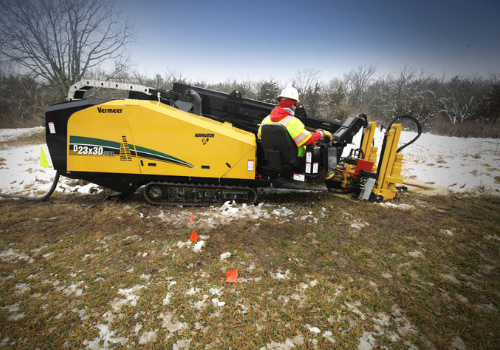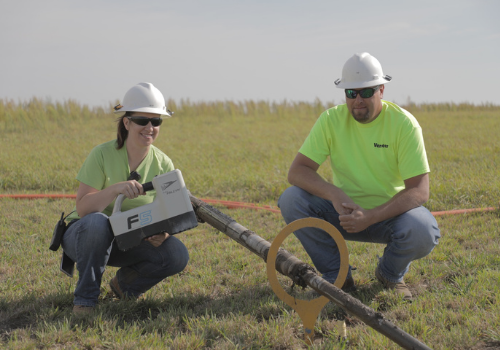Horizontal directional drilling (HDD) was developed to solve the problem of installing underground products in areas with challenging conditions such as urban settings, river crossings, rail lines and busy highways. As costs have come down and equipment design has matured, HDD may be the preferred method of putting product in the ground regardless of environment because it is often more cost effective than open trenches. Typical markets include water, sewer, electrical, fiber optic, and gas and oil.
How Does Horizontal Directional Drilling Work?
At its heart, HDD is easy to understand. Existing underground infrastructure is located. A drill rig rotates a drill string and drives it through the subsurface. This drill string consists of drill rods and a cutting head. Some method of tracking the string is used, either a stringline back to the surface or an employee with a locator walking over the bore path.
Steering is enabled by the cutting head. When the string emerges at the predetermined exit point, a backreamer is pulled back through to enlarge the initial hole. Pipe or other product is pulled through the resulting bore. Drilling fluids lubricate the parts, cool the cutting head, remove drilling spoils and stabilize the bore. Entry and exit locations are restored to their original condition to complete the process.
 Advances in the HDD Market
Advances in the HDD Market
Part of the maturation of HDD is the proliferation of HDD machines and hardware. This proliferation is driven by two things: soil conditions and bore dimensions. Imagine two HDD jobs. One is drilling through loamy soil to put 50 feet of 4-inch water pipe under a busy roadway. One is drilling through rock to put 800 feet of 30-inch sewer line under a river. Conceptually these jobs are similar; in detail they share nothing.
Beyond the HDD equipment itself are many additional requirements, a fact not always fully appreciated by those considering entering the HDD market. “For those outside the industry, there’s a general lack of knowledge of the scope of what’s required,” says Dan Vroom, industrial equipment and sales training manager, Vermeer.
“Typically you need a truck, trailer and CDL driver. You need support equipment, including a fluid mix system and a vacuum truck. Compliance is a big concern, from fluid disposal to site restoration. Scheduling and people management are important considerations.”
Selecting the Right Drill Bits
After investing in the major pieces, you’re pretty well restricted to the work your equipment will handle. But one component is easily tailored to the job: the bit. “Our Omni Bit is our universal bit,” says Cory Maker, horizontal directional drill product manager, Ditch Witch. “It works very well in a wide range of conditions.”
Why not just go with the hardest bit you can find, knowing it will gnaw its way through virtually any soil or rock? “A super-hard carbide bit probably won’t steer as well as a standard bit in some soils so it’s not the ideal choice for a primary bit,” says Maker. “On the other hand, sand is very soft but is also very abrasive. A standard bit will easily cut through sand but a carbide bit will last much longer in those abrasive conditions.”
Whatever bits you choose, maintain them and replace them when they’re worn out. “Some contractors assume if the majority of the bit or reamer teeth are still in place that the bit is still as productive as when it was new,” says Vroom. “That’s often not the case.”
 Directional Drilling Tracking Technology
Directional Drilling Tracking Technology
As with bits, tracking technology also requires careful selection. Wireline is used where walk-over is not an option (rivers, interstate highways, etc.). “Wireline initially used magnetometers,” says Richard Levings, product manager, American Augers. “But those are affected by ferrous materials, whether soil type or in-place structures, so gyroscopic systems are growing in popularity and currently account for some 40 percent of the market.”
Walk-over trackers vary in sensitivity and accuracy, which is reflected in prices. “Less expensive trackers have fewer features and don’t discriminate as well against interference as higher-cost units,” says Vroom. Interference can be a big problem. Sources of passive interference include soils with high salt or iron content and inground infrastructure with metal components. Active interference comes from handheld radios, cell phones and traffic loops.
Top 3 Considerations
Our experts offer their advice to those in the HDD market and those considering entering it.
- Buy the right equipment. HDD is highly specialized and your dealer can help you select the right equipment for the jobs you’ll be doing, starting with the right size HDD rig. Undersized machines will lack the necessary power. Oversized machines will have too big a footprint and too shallow a bend radius of the drill rods. “Models often seem very similar, but small differences do matter,” says Maker.
- Identify the support organizations that help ensure success. This includes dealers and suppliers to provide the parts and service needed to avoid downtime. Put emphasis on training. HDD procedures and equipment are involved, specific and exacting; skills learned on other equipment in other applications don’t always transfer well. And although there’s a lot of information available from multiple sources, including online and in person, those are not all reliable. “Peer-to-peer information exchange can reinforce bad information,” says Vroom. “It is not a substitute for formal, structured training.” Dealers help with training; some vocational and technical colleges are launching HDD courses, as well.
- Understand your market. You can only invest in the right equipment if you know the jobs that your equipment will be doing. Recognize that markets change. “Long-line fiber drove the market at one time,” says Levings. “North American sales went from 100 to 200 units per year in the mid-‘90s to some 4,000 units in 2000. Then the fiber bust of 2001 collapsed the market and contractors had to scramble to find other HDD work.”
All three points fit into Levings’ advice: “Develop a plan and stick to it. Doing so will maximize production, reduce costs and thereby enhance profitability.”
The cost of a utility strike can be catastrophic to an HDD contractor, so Maker offers this final caveat: “Preventing damage to utilities and infrastructure is critical. Underground environments are crowded in many places. You need a complete and accurate map of underground infrastructure and the equipment and skill to navigate your drill string through that environment.”
Products Featured in this Article:
- American Augers Horizontal Directional Drills
- Ditch Witch Directional Drills
- Vermeer Utility Directional Drills
View Video Highlights from our 2019 Show:
Join thousands of industry peers who receive utility construction industry news and trends each week. Subscribe to The Utility Expo Newsletter.












